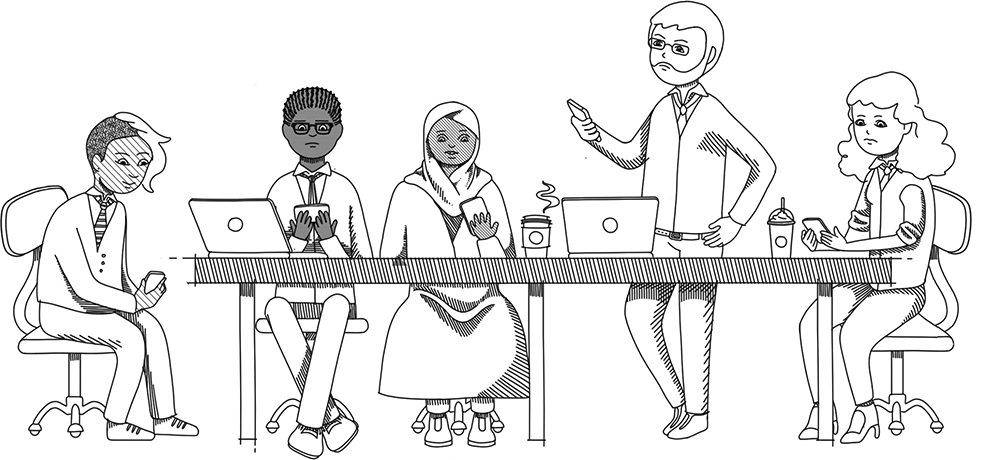How to unleash creative thinking
With presence of mind, you can free your brain to create flashes of insight.
The concept of presence of mind, as a tool for strategy, comes from one of the original writers on that subject: the Prussian general Carl von Clausewitz. In his classic book On War, published in 1832, he named presence of mind as a critical step of creative thinking. To have presence of mind is to clear away your prior notions about the situation you face: what the problem is, what the solution is, what your goal is, what the question is, what the answer is, what you want, what you expect, what you like or dislike. This gives your brain the space and time to make its own connections.
Presence of mind is difficult to foster, and it takes mental discipline to achieve. But it is crucial for creating good ideas — and it can make you happier and healthier too. The two biggest obstacles to presence of mind are excessive focus and negative thinking. Excessive focus means you can’t let go of your current understanding of the problem: your goals, your timeline, options you’ve already listed, and so on. To let your brain make new connections, you must free your mind of all that. This includes negative emotions such as anger, frustration, worry, and fear. These feelings flood the brain with the hormone cortisol, which blocks your ability to recall what you have stored in memory. You literally cannot think creatively.
When you are stuck on a problem, take the time to step away and relax. When your mind is clear, it will look to combine what is on its memory shelves and then...aha! You will have a flash of insight — a combination of examples from history that form an idea. It may not be one big Eureka moment. Instead, it may be a series of smaller insights that you hardly feel as discrete cognitive events. Regardless, the mental mechanism is the same for large and small epiphanies — it is a feeling of excitement as the idea forms.
Here is what presence of mind looks like. Let’s say two family members who are both very picky eaters are spending the night with you. You can’t decide what to make for dinner that both will like. As you go up and down the aisles of the supermarket, the contents of your cart keep changing, but each time you look at the combination, you know that your guests will not be happy with the dinner it would make.
Then you pass the egg case and remember that both of your picky eaters love a big breakfast. “Breakfast” pops into your mind as a way to reach the wider goal of pleasing your guests.
You put back all the dinner ingredients and gather the items you’ll need for breakfast instead. You’ll take your guests out for dinner tonight and make them a big breakfast tomorrow morning. Presence of mind allowed you to let go of the original specific goal of making dinner for your guests. But it did not change your general goal: to please your guests.
Creative thinking might not sound as motivating as positive thinking, but it’s a better guide to living your life.
How do you improve your presence of mind? It helps to realize you don’t always need it. If you’re working on a familiar task, go ahead and keep working until you finish it, even if it takes until midnight. With familiar tasks, you already know what to do: You don’t need a new idea, you don’t need presence of mind. But if it’s a task where you need a creative answer, don’t work until midnight. Instead, carve out time to give your mind the space to wander.
When you need a new idea, throughout the workday try to take in as many examples from history as possible that might relate to your problem. Don’t work late: Spend the evening on something that gives your mind a rest. Go to the gym, have dinner with friends, take a long shower, and above all get a good night’s sleep. This greatly increases your chances of a flash of insight to solve your problem.
You can practice this discipline in smaller bits too, by scheduling time in your day for short walks, or making coffee, or some other activity that enables you to clear your mind, if only for 15 minutes.

Don’t confuse this type of relief from excessive focus with distraction. Creative relaxation is deliberate: something you choose to do. Distraction is reactive and almost involuntary. Your mind flits from one activity to another. Some call it multitasking, but in reality you cannot do many things at once. Your brain needs time to shift from one thing to the other. When you’re distracted by each new task, there’s not enough time for presence of mind.
![]()

You might think that in a boring, useless meeting, there’s no harm done by looking at your phone. But each time you look, following the habitual distraction of a device, you’re eroding your presence of mind. If the meeting is not worth paying attention to, it’s better to intentionally let your mind wander and give your brain a moment to relax in the midst of your hectic day. As with excessive focus, reducing distraction is a matter of mental discipline. In theory, it’s simple enough: Just stop. Turn off your phone.
But in practice, habits are hard to break, and more and more people expect you to reply within minutes to every message they send you. Start small and slow, and build your tolerance for time away from your phone. As with any habit, it will take time and energy to break.
Ask yourself: How good are you at clearing your mind of all your thoughts when facing a problem? Can you forget for just a while what your goals are, what you wish for, the question you’re facing, all possible answers, and even the problem itself? Can you wipe your mind clean?
For most people this is very hard to do. But we’re in luck. We have help in developing presence of mind. Over the past few years, various forms of meditation have become popular for reducing stress to improve both mental and physical health. And there’s another benefit: Meditation helps presence of mind for creative thinking.
But not all types of meditation are equal here.

Samatha is the original Hindu name for a method called focus or monitoring meditation in English. It clears your mind except for one single thing you focus on, such as your breathing, a point you stare at, or a part of your body. Mantra meditation is similar, in that it clears your mind of everything except the word you repeat as a mantra.

Vipassana is the original Hindu name for a method called insight or acceptance meditation in English. You let your thoughts wander freely without attachment to any of them. They just flow by. The thoughts can be positive or negative — either way, you just move on to the next thought. You dwell on none of them.
We can see the difference between these two forms of clearing your mind. The first one empties it as much as possible, while the second one flushes it clean with a constant stream. Research suggests that both improve your health, but Vipassana is more effective. As you might guess, it’s also harder to do. But we can see how Vipassana helps in creative thinking, by opening your mind to a multitude of thoughts, without barriers. That’s why it’s referred to as insight meditation.
When we read the accounts of people who are known for their creative ideas, we often find that they are accustomed to letting their minds wander in the way of Vipassana meditation. They may be doing one thing, and then something unexpected leads them in a new and unforeseen direction. If instead they had focused solely on what they were doing, they would have never had their big flashes of insight. This “free-thinking” aspect of presence of mind does not necessarily require the formal discipline of Vipassana. It’s a state of mind you can carry with you wherever you go, whatever you do.
What about negative thinking, the other big obstacle to presence of mind? A key element of presence of mind is the acceptance of the impact of circumstance in the creative choices you face in life. Unfortunately, this view of circumstance contradicts a vast tradition of personal advice that has grown to universal appeal. For example, you can hear speakers at high school and college graduations put down negative thinking. Students, they say, should emphasize positive thinking instead.
No doubt: Negative thinking can be terrible. Sadly, many people grow up hearing this sort of thinking from family, friends, teachers, and often even themselves. But even positive thinking can be detrimental to presence of mind. It completely ignores the role of circumstance in what you can achieve.
We favor a third category: creative thinking. Creative thinking might not sound as motivating as positive thinking, but it’s a better guide to living your life. Indeed, if you ask any of those graduation speakers how exactly they themselves succeeded, you will find in most cases they did it through creative thinking (see table).
Life is full of twists and turns far outside your control. Circumstance, not you, will determine what elements cross your path. Accepting that, and noticing those elements you did not expect or even want, are key to mastering the art of ideas.
Author profiles:
- Amy Murphy is a leading practitioner with Strategy&, PwC’s strategy consulting group, and advises clients on innovation, strategy, and capability development. She is a director with PwC US, based in Washington, DC.
- William Duggan is a professor at Columbia Business School, where he teaches innovation in the MBA, executive MBA, and executive education programs.
- Excerpted from The Art of Ideas: Creative Thinking for Work and Life. Copyright © 2020 William Duggan and Amy Murphy. Used by arrangement with the Publisher, Columbia Business School Publishing. All rights reserved.






